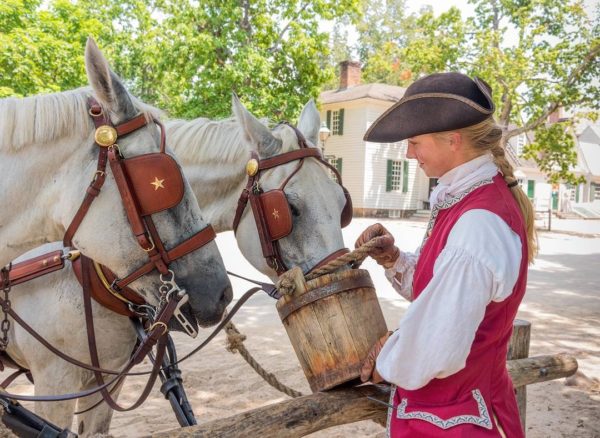
The heat index soared this weekend, and that naturally raises questions about safety—for both our costumed interpreters and animals. Besides plenty of water, breaks, and shade, Coach & Livestock utilizes a heat index policy for working animals.
Cattle—like dogs—cannot sweat, so they are removed from work when the heat index reaches 95°.
Horses can sweat, making them more equipped for hot temperatures. Still, safeguards are in place. For working horses, each “shift” begins and ends with a cold-water rinse. Soap is not usually involved, as this rinse is meant to wash away sweat and cool the animal down. Hot weather also means meals of grain topped with electrolyte powder. The horses enjoy the taste (the powder comes in flavors like apple and mint), but more importantly, it helps replenish salt lost through sweat.
So what happens when the mercury goes up? It depends on the heat index. When the heat index hits 100°, the carriage horses sit out every other ride. This allows for more water breaks and rest in the shade. When the heat index reaches 105°, all carriage rides are suspended. The same threshold applies to interpreters riding horses through the Historic Area.
Similar precautions are in place for our Leicester Longwool sheep. On a regular day, you will see the sheep being herded around the Historic Area—you can even track them on our award-winning CW Explorer App. When the heat reaches 95°, however, they are taken straight to a pen on Market Square, where they have plenty of shade and water. If the heat index reaches 105°, the sheep are not taken out into the Historic Area at all.
When the animals are not working, they are either in a pasture with shade trees, or in the stables where large ceiling fans run constantly to provide air circulation. Automatic watering bowls have replaced the wooden troughs used in the “olden days,” which encourages all animals to drink and stay hydrated during the hot summer months.
All of these measures funnel toward one fundamental goal: happy, healthy animals. You can rest assured that the well-being of our Rare Breeds is a top priority.
Want to learn more about our Rare Breeds Program? Check out the Bits & Bridles tour! This one-hour walking tour of the Colonial Williamsburg stables provides a behind-the-scenes look at our facilities, carriages, and the chance to get up close and personal with some of our animals.
Christine Gifford says
I definitely recommend the Bits and Bridles tour. When we visited in May of 2016 I went on the tour in hopes of seeing the new lamb, Edmund, and I did see him in the stable with his brother. Also, I learned about horse shoeing, saw the many carriages used in the historic area, and saw other livestock. Please, if possible, would you give me an update on Edmund, the lamb who needed special care after he was born?
Thanks for your question, Christine. Unfortunately, Edmund the lamb passed away last year. The internal complications from his birth proved more extensive than we knew. You can read more here: http://bit.ly/2uGxQ0x
Christine Gifford says
That is sad, but I appreciate your letting me know.
Thank you,
Christine
Tawanna Yelton says
Thank you so much for carinf for these wonderful creatures. CW wouldnt be the same without them.
Are the sheep herded at market square in such a way that they cut down on mowing? Were sheep used in colonial times for that purpose; for example, to keep grass trimmed on the Palace Green?
Thanks for your question, Mary Anne. Here’s the reply from our colleagues in Coach & Livestock:
“Currently our sheep are not herded to cut down on mowing. They can be rather picky when deciding what grass to eat, and normally go for clover or weeds. In colonial America, sheep were not used to cut the grass. Sheep were bred for wool or meat rather than lawn maintenance. They would have gardeners who would take care of the lawns.”
I’m glad you take such good care of your animals. What do you do for your human employees?
Thanks for your comment, Helene. Here’s a blog that discusses how our costumed interpreters deal with the heat: http://bit.ly/29SKh04
Thank you so much for a new blog. Especially about animals. My grandson loves the sheep. Still have the video from 2 years ago. Have to play it every time he comes. As our whole family has been to CW many times, can’t wait to take our grandchildren when they get old enough! Again thank you for going forward!
I always enjoy blogs on the animals. My wife and I had five horses for 35 years, along with chickens, guinea fowl, peacocks and cats dogs.
It’s good to see CW’s animals receive such care.
That means a lot to us.